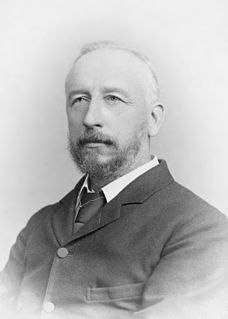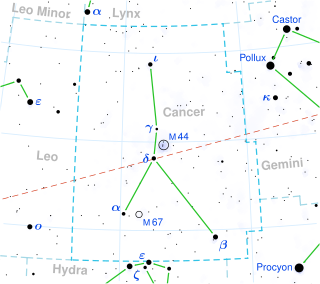
Williamina Paton Stevens Fleming was a Scottish astronomer active in the United States. During her career, she helped develop a common designation system for stars and cataloged thousands of stars and other astronomical phenomena. Among several career achievements that advanced astronomy, Fleming is noted for her discovery of the Horsehead Nebula in 1888.

Annie Jump Cannon was an American astronomer whose cataloging work was instrumental in the development of contemporary stellar classification. With Edward C. Pickering, she is credited with the creation of the Harvard Classification Scheme, which was the first serious attempt to organize and classify stars based on their temperatures and spectral types. She was nearly deaf throughout her career. She was a suffragist and a member of the National Women's Party.

Mintaka, designation Delta Orionis and 34 Orionis, is a multiple star system some 1,200 light-years from the Sun in the constellation of Orion. Together with Alnitak and Alnilam, the three stars form Orion's Belt, known by many names among ancient cultures. The star is located very close to the celestial equator. When Orion is near the meridian, Mintaka is the rightmost of the Belt's stars when viewed from the Northern Hemisphere facing south.
Eleanor Margaret Burbidge, FRS (néePeachey; 12 August 1919 – 5 April 2020) was a British-American observational astronomer and astrophysicist. In the 1950s, she was one of the founders of stellar nucleosynthesis and was first author of the influential B2FH paper. During the 1960s and 70s she worked on galaxy rotation curves and quasars, discovering the most distant astronomical object then known. In the 1980s and 90s she helped develop and utilise the Faint Object Spectrograph on the Hubble Space Telescope. Burbidge was well known for her work opposing discrimination against women in astronomy.

Sir David Gill was a Scottish astronomer who is known for measuring astronomical distances, for astrophotography, and for geodesy. He spent much of his career in South Africa.

1 Aquarii is a binary star system in the zodiac constellation of Aquarius, about 257 light years away from the Sun. 1 Aquarii is the Flamsteed designation. It is visible to the naked eye as a faint, orange-hued star with an apparent visual magnitude of 5.151, located a degree north of the celestial equator. The system is moving closer to the Earth with a heliocentric radial velocity of −41 km/s.
16 Aurigae is a triple star system located 232 light years away from the Sun in the northern constellation of Auriga. It is visible to the naked eye as a faint, orange-hued star with an apparent visual magnitude of 4.547, and is located about 2/3 of the way from Capella toward Beta Tauri. It also lies in the midst of the Melotte 31 cluster, but is merely a line-of-sight interloper. The system has a relatively high proper motion, advancing across the celestial sphere at the rate of 0.166 arc seconds per annum, and is moving closer to the Earth with a heliocentric radial velocity of −28 km/s.

13 Cancri is a K-type giant star in the constellation Cancer. It has an apparent magnitude of +6.41 and is approximately 970 light years from Earth.

Tau Canis Majoris is a multiple star system in the constellation Canis Major. It is approximately 5,000 light years distant from Earth and is the brightest member of the open cluster NGC 2362.
4 Canum Venaticorum is a binary star system in the northern constellation of Canes Venatici, located around 425 light years away. It has the variable star designation AI Canum Venaticorum; 4 Canum Venaticorum is its Flamsteed designation. Its brightness varies from magnitude +5.89 to +6.15 with a period of 2.8 hours, which places it around the lower limit of visibility to the naked eye. This was found to be a binary by Schmid et al. in 2014, based on periodic, non-sinusoidal changes in its radial velocity. It is a single-lined spectroscopic binary with an orbital period of 124.4 days and an eccentricity of 0.31.

Business and Professional Women's Foundation (BPW) is an organization that promotes workforce development programs and workplace policies to acknowledge the needs of working women, communities and businesses. It supports the National Federation of Business and Professional Women's Clubs.
HD 59686 is a binary star system in the northern constellation of Gemini. It is visible to the naked eye as a dim point of light with an apparent visual magnitude of +5.45. The distance to this system is approximately 292 light years based on parallax, but it is drifting closer with a radial velocity of −34 km/s.

The Hertzsprung–Russell diagram, abbreviated as H–R diagram, HR diagram or HRD, is a scatter plot of stars showing the relationship between the stars' absolute magnitudes or luminosities versus their stellar classifications or effective temperatures. The diagram was created independently in around 1910 by Ejnar Hertzsprung and Henry Norris Russell, and represented a major step towards an understanding of stellar evolution.
HR 7955 is a binary star system in the northern circumpolar constellation of Cepheus, near the constellation border with Cygnus. It has a yellow-white hue and is faintly visible to the naked eye with a combined apparent visual magnitude of 4.51. The system is located at a distance of 89 light-years from the Sun, based on parallax. It has a relatively high proper motion, traversing the celestial sphere at the rate of 0.243 arc seconds per annum, and is drifting closer to the Sun with a radial velocity of -33 km/s.
μ Cygni, Latinised as Mu Cygni, is a binary star system in the northern constellation of Cygnus. It is visible to the naked eye as a faint point of light with a combined apparent visual magnitude of 4.49. The system is located 72 light years distant from the Sun, based on parallax, and is drifting further away with a radial velocity of +17 km/s.
70 Pegasi is a binary star system in the northern constellation Pegasus. It is a faint star, visible to the naked eye under good seeing conditions, with an apparent visual magnitude of 4.56. The measured annual parallax shift measured from Earth's orbit is 18.65 mas, yielding a distance estimate of around 175 light years. The visual magnitude of the star is diminished by an extinction of 0.07±0.02 due to interstellar dust. It is moving closer to the Sun with a radial velocity of −17 km/s.
74 Virginis is a single star in the zodiac constellation of Virgo. It is visible to the naked eye as a faint red-hued star with an apparent visual magnitude of 4.69. The star is positioned near the ecliptic and thus is subject to lunar occultations. The measured annual parallax of 8.16 mas provides a distance estimate of around 400 light years from the Sun. At that range, the visual magnitude of the star is diminished by an extinction of 0.46±0.02 due to interstellar dust. It is moving further from the Earth with a heliocentric radial velocity of +19 km/s.

Bernice C. Downing was an American newspaper publisher and editor, postmaster, and speaker. She and her twin sister, Bertha C. Downing, were the first women in California to own, edit, and publish their own newspaper, the Santa Clara Journal.

Winifred May Horman Hausam was an American vocational executive who founded and managed vocational service bureaus for women in the Los Angeles area. Active in a wide variety of business, educational and women's clubs, she headed the Western Personnel Institute in Pasadena for over 30 years. She also helped to establish programs for women during the Depression, providing jobs for skilled women.
34 Pegasi is a triple star system in the northern constellation of Pegasus. It has a yellow-white hue and is dimly visible to the naked eye with an apparent visual magnitude of 5.76. The system is located at a distance of 131 light years from the Sun based on parallax, but is drifting closer with a radial velocity of −13.5 km/s. It has been catalogued as a member of the Hyades Supercluster, although its membership status remains doubtful.











